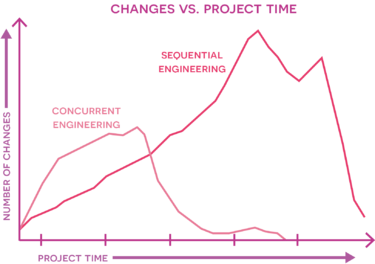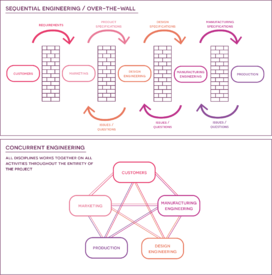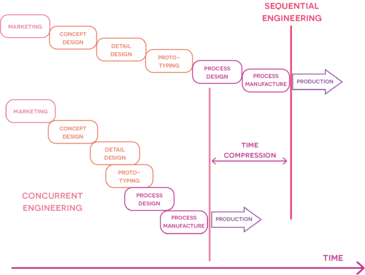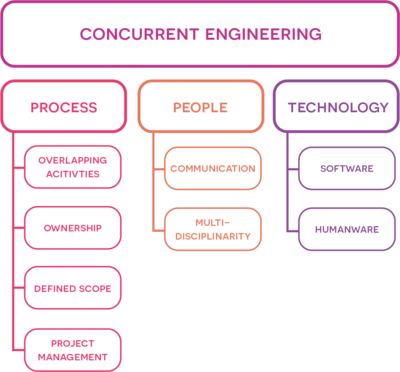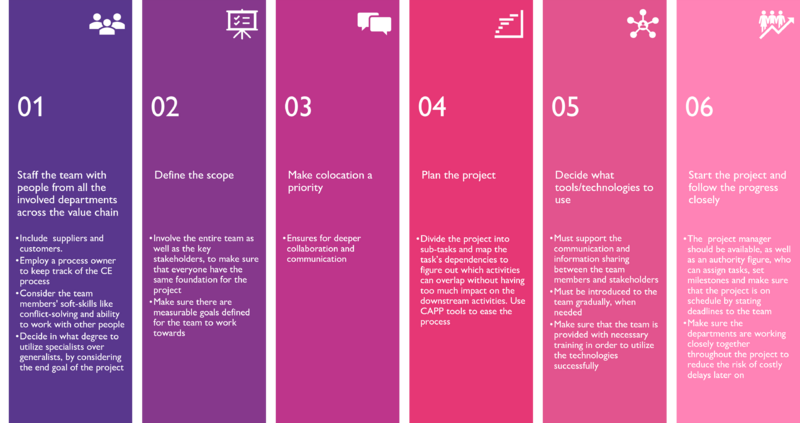Concurrent Engineering
Written by Helena Søndberg Svendsen
Contents |
Summary
Concurrent Engineering (CE) is a project management approach that integrates multiple engineering disciplines and project functions into a cohesive and streamlined process, which, from a project management perspective, requires attention to three key aspects when implementing: Process, People, and Technology/tools. In terms of Process, CE emphasizes overlapping activities, shared ownership, and a defined scope. Overlapping activities ensure that different aspects of the project can be worked on simultaneously, reducing lead time and overall project duration, while shared ownership promotes collaboration and accountability among team members, and a defined scope helps to manage expectations and prevent scope creep. The People aspect of CE involves communication and the use of multidisciplinary teams. Effective communication is essential for sharing information and resolving conflicts, while multidisciplinary teams bring together a diverse range of expertise and perspectives to solve complex problems. Technology/tools play a crucial role in facilitating CE by selecting and deploying appropriate tools and technologies that can help automate tasks, improve accuracy, and enhance collaboration. However, implementing CE can face barriers such as resistance to change, a lack of resources, inadequate training, and difficulties in coordinating cross-functional teams. Overcoming these barriers requires sustained effort, including top management support, effective communication, and a mindset of continuous improvement. Overall, the successful implementation of CE can result in significant improvements in product quality, time-to-market, and customer satisfaction.
Introduction
Context
In the 1980s, companies faced more frequently occurring issues within product development[1]. These had to do with the product life-cycle becoming shorter, everchanging customer demands, the cost of product development becoming increasingly more costly as the product complexity increased, and the integration of new technology becoming increasingly cumbersome, which meant the market became greater and more worldwide. These issues have only grown up until today, so as a reaction to these issues faced within society, the proposed answer became Concurrent Engineering, according to theory[2]. With the overall goals of increased productivity and lower costs through shorter development times and quicker time-to-market, CE acts as a direct response, contrary to the prior traditional "over the wall", sequential engineering (SE) strategy.
What is Concurrent Engineering?
Concurrent engineering is neither a technique nor a tool. It is a manner of thinking that calls for a wide range of techniques and methods. The execution of a project's processes simultaneously with the participation of both upstream and downstream functions throughout the project's life cycle is the very essence of concurrent engineering[3]. The approach aims to decrease the number of larger iterations further down in the process, where the impact is much greater, by encountering and solving them as they appear in the earlier phases of the project (figure 1). This is made possible by the concurrent nature of the approach, in which integrated, multifunctional teams collaborate and work together simultaneously to address multiple project-related issues at the same time. As control and responsibility are shared amongst the departments across the project's phases, and because their activities overlap, they can identify potential problems as they appear and can address them faster[4]. This is opposite to the traditional sequential engineering (SE) approach, where each activity is handled by one functional organization at a time (marketing, design, manufacturing, etc.) and then thrown "over-the-wall" to the next organization (figure 2) without communication. The problem with this approach is that it might be in the very late stages of the process that a problem is identified, because of the lack of communication between organizations, which will result in the activity/product being sent back over-the-wall to fix the issues[5] resulting in a prolonged process time and increased costs. By working concurrently the overall project duration is greatly reduced, as there is constant collaboration and iterations between the teams in the process, ensuring that larger and time-consuming issues will not occur in the final stages when changes can be both costly and time-consuming. The reduction in time for CE compared to the sequential approach can be seen in figure 3. And the benefits of the implementation of CE in a project setting can also be deduced from the figure, as it results in increased productivity and an overall lower cost of the project due to the reduction in duration[4]. This also means that the time-to-market for the potential product or service is also decreased, providing the company with a competitive advantage on the market compared to its competitors.
Implementation
Concurrent engineering can be implemented in any organization, the main prerequisite being major organizational changes. As previously stated, CE requires strong collaboration and communication across the project's numerous phases and disciplines and is fundamentally a socio-technical concept because of the concurrent nature of the method[3]. The elements affecting the success of CE and the implementation can be condensed into three categories: Process, People, and Technology/Tools. In the following sections, these will be explored with a focus on what aspects to consider, when attempting to implement CE in a project setting.
Process
- Considering and planning overlapping of activities
- Ensuring that ownership of the process occurs
- Defined, clear and quantitative goals
- Project management activities
Overlapping activities
Defining the process, creating the corresponding schedule of activities, and deciding how to handle the necessary overlapping activities are the first steps in adopting CE. For the project to be completed most effectively and efficiently, this includes how and when the tasks should overlap and where all risks are taken into account early in the process. When there is strong communication and cross-disciplinary teamwork, overlapping activities have been found to shorten development time, but there is also evidence that it is not always advantageous for project governance[5]. This can occur if there are two or more overlapping operations, in which case modifications in the upstream activities necessitate significant changes in the downstream activities, which have already been finished as a result of the overlapping. Therefore, to minimize the number of actions that need to be redone, it is crucial to take into account which activities are overlapping and that the downstream impact is taken into account before planning overlap.
Ownership and defined scope
Since the absence of ownership equates to a lack of project discipline, a process owner must be appointed for the CE process. When an issue arises, the team must be able to turn to the person in charge for guidance. The primary responsibility of the process owner is to ensure that the CE process is correctly implemented and updated as needed. Having a process owner ensures better reactivity to impending changes and better learning for future process improvements since a process owner is responsible for both the full process and the linked sub-processes[5]. However, for the process owner to be successful in implementing CE, there must set forth, explicit and measurable project goals. For the project team to have a shared knowledge of the objectives when working simultaneously on the project, the scope must be precisely specified. This will help to reduce misconceptions as the project progresses. progresses.
Project management
The primary responsibility of the project manager is planning the project, which can be challenging given the simultaneous nature of the approach and the overlapping activities. To reduce the project's complexity and create a framework for stage-gate procedures and phase evaluations, the project manager must carefully design the project by dividing it into smaller subphases. All project phases must be taken into account in order to correctly map all the dependencies of the overlapping activities, and then to plan when the parallel and overlapping activities can occur, ensuring the influence on the downstream activities is kept to a minimum[6]. Additionally, planning is done to anticipate, identify, and take precautions against any risks related to the various tasks. The project manager uses the milestones and phase reviews to assess whether the project is on track, whether additional resources are required, and whether a delay is occurring. If so, it is the project manager's responsibility to get in touch with the appropriate parties to secure the project's future progress or, if necessary, to put the necessary risk management measures in place to lessen the impact while still staying within budget.
People
- Need for close communication between team members
- Need for multidisciplinarity
Communication
A few prerequisites must be met for a CE team to succeed for the project to get off to the best potential start. These requirements suggest that an effective team should have no more than 10 members and that each member must choose to work on the project of their own free will and be driven by their intrinsic motivation to continue working on it until completion [4]. In addition, for the team to be able to successfully execute the project, it must have at least one representative from each of the major disciplines involved. Since strong communication between the phases/disciplines is necessary to reap the benefits of a CE strategy, it is crucial to keep this in mind before embarking on the project since this might necessitate some changes to function properly.
This includes colocation [4], in which the project team is physically situated close to one another. This has been demonstrated to considerably enhance both problem-solving and decision-making since they have constant access to both the people and the information related to the project. By physically putting the team members close to one another, they are more likely to talk about issues and assist one another in solving them. It also helps to strengthen the team's bond by ensuring that the group views itself as a team rather than a group of individuals sharing knowledge, which in turn strengthens communication[7]. Due to the overlapping nature of CE, the team members' sensitivity [4] to each other's tasks, is also an important factor in the need for communication. For example, if one team member is working on an upstream task, the other team members are highly sensitive to the outcome of that task because it affects their downstream tasks, and as a result, they are more eager to keep each other updated to streamline the process.
Multidisciplinary teams
The usage of multidisciplinary teams, which in this context means that the project team is made up of experts from all the various stages of the project's life cycle, is the most important component of CE. Depending on the project's scope and objectives, this may comprise individuals from the marketing, design, manufacturing, and programming departments, for example. The inclusion of the client and the supplier in the team has also been demonstrated to be a valuable contribution, as their skills can decrease the number of iterations and lead time throughout the project[1].
The idea behind multidisciplinary teams is that all departments collaborate from the start of the project to foresee potential issues and solve them quickly before they have a chance to cause expensive delays. The project manager facilitates communication by setting up these multidisciplinary teams so that all parties involved in the project can communicate directly and promptly with one another across departments to submit their inputs before the project is completed and reach decisions quicker[8]. The departments can gain greatly from this form of communication by utilizing one another's skills and experience to minimize the number of time-consuming adjustments by discussing problems as they arise and solving them as a team[1]. For instance, can manufacturing begin estimating costs based on the early designs, allowing them to begin ordering the necessary machinery, which subsequently can minimize the lead time of waiting for the machines to start manufacturing the product.
Technology
- Software: Information and communications technologies
- Humanware: Training of team to utilize tools and approach
Software
Software technologies refer to the techniques, methods, and procedures people use to perform their tasks, whether or not they are automated by computer software. The management of CE can be conducted more efficiently, especially with the help of integrated communication and information technology solutions[9]. Efficient data-sharing methods are essential for the preservation, retrieval, and exchange of information between parties and help the team make informed decisions more quickly[5], as all project-related information is always available to all team members through software like Sharepoint. Additionally, having access to computer-aided process planning tools (CAPP) makes it simpler and more efficient for the project manager to plan the team's activities. It also makes it simpler to visualize and explain the project's progress[9]. This can be accomplished by using program-based Gantt charts or even by employing Lead & Lag to plan the project. Product Lifecycle Management (PLM) training is also a great resource when working in the context of CE because it enables multidisciplinary teams to collaborate and organize the project across the value chain, keeping everyone updated on the status of the project and any sudden changes to the product, and minimizing time delays.
Humanware
The project manager is responsible for making sure that team members are communicating effectively and that the appropriate channels have been established. The same holds for providing the team with the toolbox of knowledge, methodologies, technologies, and software required for the concurrent project environment so that everyone on the team is working from the same set of project-related ground rules[9]. However, training is necessary for the team to use the technology effectively. Given that working on a CE project requires tight collaboration between disciplines, the project manager must be able to provide the team with direction and specialized training in what it entails to work on a CE project [5]. Hence, in order to reach the "first-time-right" in less time, the team's onboarding process must place a strong emphasis on helping the team understand all of the nuances of the project itself and the technologies used.
Implementation approach
The following figure provides an overview of everything to consider, when implementing CE in an organization.
Reflections on application
While considering CE and its current applications, it is clear that a lot has changed since the 1980s, when it was first developed. Initially, it was primarily a design-manufacturing-oriented strategy, but as time went on, it eventually expanded to include more lifecycle functions and value chain actors, which led to a reduction in overall production time and an improvement in delivery quality. It is for these reasons, in particular, that industrial giants like General Motors, Hewlett-Packard, Ford, and others[3][4]), have opted to use CE when doing New Product Development (NPD). This area is the most common one used for CE, where the need for customer involvement has grown tremendously over the years, as the customer's requirements are continuing to grow, the companies, to stay relevant as well as maintain a competitive advantage in the market, needs to continuously include the customer as a stakeholder throughout the development process[3]. With multidisciplinary teams, including customers and suppliers, at the core of using CE, it helps companies within NPD to incorporate Customer Involvement throughout their development processes. In extension, the flexibility of activity planning when using CE enables the companies to include customer activities, whether at the planning of the project as well as during, without impacting the overall schedule.
The approach is mostly used by medium-sized to large businesses[10] working on exceedingly complex projects to boost productivity, enhance quality, and keep a competitive edge in the market. These businesses, which have already effectively implemented and are fully adopting CE, are spread across numerous European nations as well as the United States. Yet although the Western countries are using CE successfully and are benefiting from it, the Asian countries — even though they also work on immensely complex projects — only use the manufacturing approach[11] because of culturally different standards.
Barriers
The actual implementation of CE can in practice take years of gradual organizational changes and building experience for the people involved, but not all companies are successful with the implementation in the end. Below some of these barriers will be addressed, and how to overcome them.
The major obstacles are organizational in nature and have to do with the project team's relationship with senior management. While implementing CE, it is crucial to have the backing of top management because, without it, every attempt to bring about a constructive change is doomed from the start. The cooperation and communication needed for the project team to work effectively must therefore start at the management level to have the best basis. Another obstacle is a poor business climate [12], which is also impacted by top management. This means that for collaboration and new techniques to be used, the project team's tasks must be clearly defined and of a low degree of ambiguity for all parties. If not, the project will either come to a standstill or go in an undesirable direction, which will make the team members dissatisfied and cause delays. The final obstacle has to do with a lack of customer interaction. As previously stated, it is crucial to involve the customer throughout the entire project to ensure that their needs are met at all times. If not, the project may wind up failing completely, which could lead to the firm having an unpleasant experience with CE and choosing not to adopt it in the future.
Project, Program & Portfolio context
It is feasible to think of CE as a program and the various activities/stages that take place inside CE as projects in the context of project, program, and portfolio management. This is conceivable since the goal of a program is to manage the realization of benefits[13], which in the context of CE refers to the reduced cost made possible by overlapping activities. Along with being one of CE's key characteristics, a program is also defined by the relationships and interdependencies between its various components. These components or activities can be compared to projects[14] in that they are short-term initiatives with a clearly defined goal that varies depending on where the activity is in the life cycle. All of these projects are therefore moving in the same direction toward a common objective, which, in the case of NPD, will produce a final product or deliverable[15].
So, from a PPP standpoint, CE may be viewed as a program management technique, where the governance of the framework must be put in place by the program manager, and then it is their responsibility to lead the project managers (representatives from each discipline) to carry out the projects so that the deliverable, and consequently the benefit, can be realized. Throughout the program's entire life cycle, the program manager is in charge of managing its complexity and uncertainties[14].It entails mapping out potential risks that could cause a delay for one or more of the projects, as well as organizing the program's projects and its overlapping operations. As the benefits cannot be realized if the components are managed individually, it is essential for the program's success to keep all the projects on track and in alignment. If done successfully, the benefit of lowering the process' overall cost as well as reducing the time-to-market can be realized, and the organization can benefit.
Bibliography
Concurrent Engineering in the 21st Century: Foundations, Developments and Challenges[3]
The newest advancements and industry-best practices for the guiding principles of the framework are covered in-depth in this book's presentation of concurrent engineering. It delves deeply into CE procedures and practices, as well as practical applications and experiences. The book offers a thorough overview of CE from many different viewpoints and industries since it is a compilation of research by numerous professors and scholars.
Concurrent Engineering - Contemporary issues and modern design tools[16]
The book provides a holistic understanding regarding what the approach entails and some comprehensive reflections on the implementation process. It covers the organizational issues related to concurrent engineering as well the tools and techniques aspect of the approach. Here, the most interesting chapter is the one referenced below[12] about overcoming barriers regarding the implementation process particularly relevant, as well as the chapter about the common failures and success factors when implementing the approach in practice.
Organizing for concurrent engineering: an integration mechanism framework[9]
In the article, the mechanisms of how to integrate CE in an NPD framework are explained as “integration by strategy, process, technology, and organization,” as well as examples of how this can be done in a real-world case application. The article is summed up with a test on the effectiveness of these mechanisms across different companies, and it is found that the success of the mechanisms varies greatly from one company to another. This is an interesting takeaway for other companies, if they are interested in implementing CE, they can utilize this article as a pilot project and adapt the findings to their context.
References
- ↑ 1.0 1.1 1.2 Trygg, L. (1993). “Concurrent Engineering practices in selected Swedish companies: a movement or an activity of the few?” in Journal of Product Innovation Management, 10(5), pp. 403–415. Available at: https://doi.org/10.1016/0737-6782(93)90098-B
- ↑ Clark, K.B. & Fujimoto, T. (1991). Product development performance: strategy, organization, and management in the world auto industry. Harvard Business School Press, Boston
- ↑ 3.0 3.1 3.2 3.3 3.4 Stjepandić J., et al. (eds) (2015) Concurrent engineering in the 21st Century: foundations, developments and challenges. Switzerland: Springer International Publishing.
- ↑ 4.0 4.1 4.2 4.3 4.4 4.5 Swink, M.L. (1998). “A tutorial on implementing concurrent engineering in new product development programs,” in Journal of Operations Management, 16(1), pp. 103-116. Available at: https://doi.org/10.1016/S0272-6963(97)00018-1.'
- ↑ 5.0 5.1 5.2 5.3 5.4 Bhuiyan, N. et al. (2006). “Implementing Concurrent Engineering” in Research-Technology Management, 49(1), pp. 38-43. Available at: https://doi.org/10.1080/08956308.2006.11657357
- ↑ Ainscough, M. & Yasdani, B. (2000) "Concurrent Engineering within British Industry" in Concurrent Engineering 8(1), pp. 2-11. Available at: https://doi-org.proxy.findit.cvt.dk/10.1177/1063293X0000800
- ↑ Smith, P.G. (1998) “Concurrent Engineering Teams,” in D.I. Cleland (ed.) Field Guide to Project Management. John Wiley & Sons, pp. 439–450, chapter 32.
- ↑ Ebrahimi M., S. (2011). Concurrent Engineering Approaches within Product Development Processes for Managing Production Start-up phase (Dissertation), pp. 45-86. Tekniska Högskolan i Jönköping.
- ↑ 9.0 9.1 9.2 9.3 Paashuis, V. & Boer, H. (1997). "Organizing for concurrent engineering: an integration mechanism framework" in Integrated Manufacturing Systems, 8(2), pp. 79-89. Available at: https://doi-org.proxy.findit.cvt.dk/10.1108/09576069710165765.
- ↑ Grum, J. & Starbek,M. (2000). "Concurrent engineering in small companies" in International Journal of Machine Tools & Manufacture, Volume 42, pp. 417-426. Available at: https://doi.org/10.1016/S0890-6955(01)00111-0
- ↑ Ogawa, A. (2008). Concurrent Engineering for Mission Design in Different Cultures (Dissertation), pp. 1-17. Japan: Kyoto University.
- ↑ 12.0 12.1 Maddux, G.A. & Souder, W.E. & (1993). Overcoming barriers to the implementation of concurrent engineering. In: Parsaei, H.R., Sullivan, W.G. (eds.) Concurrent Engineering. Springer, Boston, MA. https://doi.org/10.1007/978-1-4615-3062-6_4
- ↑ Dansk Standard (2017). ISO 21503: Project, Program and portfolio management - Guidance on program management. Nordhavn: Danish Standards Association.
- ↑ 14.0 14.1 Dansk Standard (2020). ISO 21502: Project, Program and portfolio management - Guidance on project management. Nordhavn: Danish Standards Association.
- ↑ Dansk Standard (2021). ISO 21500: Project, Program and portfolio management - Context and concepts. Nordhavn: Danish Standards Association.
- ↑ Parsai, H.R. & Sullivan, W.G. (eds) (1993). Concurrent Engineering - Contemporary issues and modern design tools. Malta: Springer Science+Business Media.
